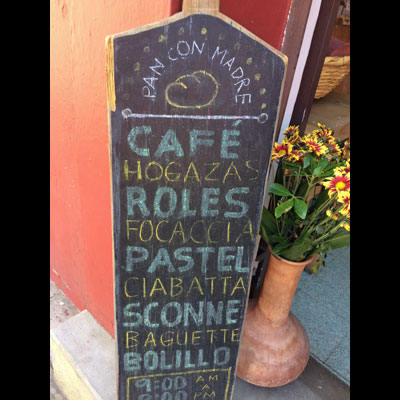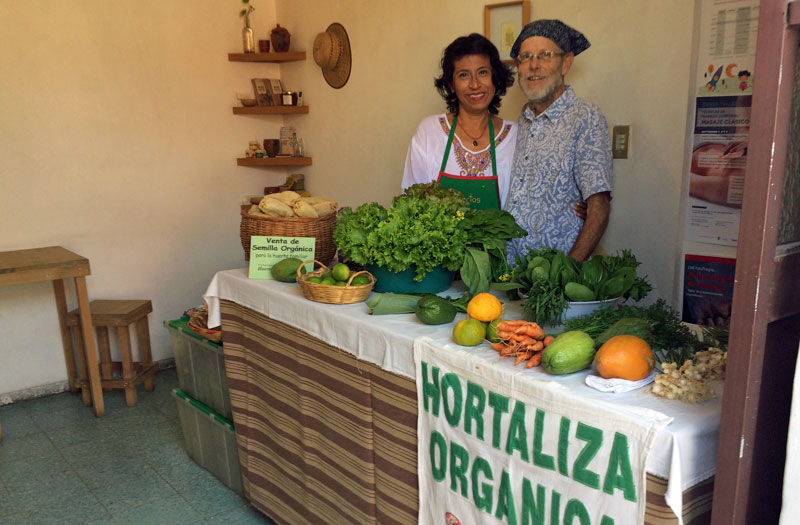[Click on BLUE links for sources and information]
Two years ago Think in the Morning wrote about Monty and Pilar (Huertos Bi Nisa): Some Traditional Markets of Oaxaca. Since then their Saturday market location has moved from outside Casa de las Bugambilias on Reforma Street to Porforio Diaz 816 next to the lovely small bakery Pan con Madre.

When they are not working in their beautiful organic garden, both Monty and Pilar write. All of the stories are composed in Spanish. Some are available on their website Huertos Bi Nisa. A Saint in the Compost was translated to English by Monty for another blog site (Jaguar Speaks). Monty graciously allowed TITM to post the story.
In organic cultivation, compost is very, very important. Let me share a related anecdote.
A Saint in the Compost, by Montgomery Howard
A couple of weeks after turning the pile, it’s ready to sift. Scoop up a forkful of compost and throw it on the sifter. Work it around a bit. Toss what doesn’t go through the sifter to one side, to be used as starter for the next pile. Bag up what does go through, to be used as soil conditioner and fertilizer. Just one of so many routine jobs in the garden. This final step in the preparation of compost, like the other routine jobs, lends itself well to “being here now”, really getting into the moment for all its worth. Some very rich sensations are involved. It also, however, lends itself well to divided attention. That is, it can be done on autopilot, leaving me to “wander elsewhere now”.
So there I was, wandering elsewhere then, when a flash of green caught my eye as the forkful hit the sifter. Seeing green in the compost at this stage of development is unexpected. Soft yellows and browns and deep black are the colors that usually meet the eye. But seeing green, and having a sense that what I saw wasn’t compostable, I bent down to pick the thing up. It wasn’t compostable at all. It was made of plastic, smeared filthy with compost. Cleaning it a bit with my gloved hand, I saw it was a little capsule of transparent green plastic with a small amount of dirty water and some kind of something solid inside. I set it aside and continued my work. I managed to extract six five-gallon buckets of compost ready for the beds, as was usual. It was mid August and the last time I’d sifted the compost was three months earlier, as was also usual. It was usual, and it was insufficient. I just didn’t have enough kitchen waste, the fresh material, to combine with the dry material I have in abundance to be able to produce enough compost for the area I had in cultivation.
Later, when I washed the capsule off, I recognized it for what it was. It was a capsule with a tiny cast metal sculpture of a saint inside, Pilar has some on her altar. I’d found a saint in the compost! I managed to remove the flat bottom of the capsule, so I also cleaned the inside and the saint himself. Then I dried it all well and reassembled the capsule. I decided to put it on Pilar’s altar, since she has similar images there. I did so, then promptly forgot all about it.
A few days later when Pilar was putting fresh flowers in the vase on her altar, she got very excited at seeing Saint Judas Tadeo. “You’re back!”, she exclaimed. “Where’ve you been?” She picked him up, looked him over well, and put him back on the altar. She surrounded him with a couple other of his images, then arranged a few flowers in a small vase just for him. She was very happy. Pilar may not go to Mass often, but she maintains her altar with devotion.
She came out to the garden where I was weeding the beds to tell me about the reappearance of her image of Saint Judas Tadeo. When she described the image I knew it was the saint I found in the compost, so I told her the story. I asked her what he is the patron saint of. Of Difficult and Desperate Cases was what she told me. “Well,” I told her, “I hope he sees my difficult and desperate case and becomes as well the Patron Saint of Compost”. She laughed at that, but then said that surely he was pleased to have been found, cleaned, and returned to his place on the altar, so maybe he’d help us out.
We pieced together how he came to be in the compost pile. In May, the Frangipani blooms. The beautiful white, very fragrant flowers are one of Pilar’s favorites to use on the altar. They don’t have long stems, so she just lays them on the table, covering the entire surface, except for spaces around all the images she has there. After a few days they’re dry, so she picks them up and tosses them into the compost can in the kitchen. Saint Judas must’ve been caught up in the beauty or fragrance of the flowers. Pilar didn’t see him in the dried flowers and he wound up in the compost can. A few days after that he was in the compost pile where he resided for the next three months.
The Sunday after I found Saint Judas in the compost, we were approached by Celia, who sells fresh organic fruit and vegetable juices at the market. She asked if we would like to have all the waste from her Sunday sales. Of course, we said, and I told her I’d bring the buckets back clean every Sunday to fill again. It’s more than two times what we generate weekly in our kitchen. As a result, now I sift out six to eight buckets of rich compost, nature’s perfect plant food, every month!
So San Judas Tadeo, the Patron Saint of Difficult and Desperate Cases, is as well our Patron Saint of Compost.
Let us pray:
“Saint Judas Tadeo, Patron Saint of Compost and of Difficult and Desperate Cases, convert this organic matter into a rich fertilizer to aid our soil. Come help us with this great need so that we may receive the nutrients that give solace to our fruits and vegetables. We promise, Glorious Saint Judas, to never forget this great favor, and to do everything possible to foster organic cultivation in your devotion. Amen”

San Judas Tadeo
Spanish Version
En el cultivo orgánico, la composta es muy, muy importante. Déjenme compartir una anécdota relacionada.
Un Santo en la composta por Montgomery Howard
Un par de semanas después de voltear la pila, está lista para colar. Recoge un tenedor lleno de composta y tírala en la coladera. Muévela sobre la coladera. Echa a un lado lo que no pasa por la coladera para usarse como inoculante para la próxima pila. Embolsa lo que sí pasa para usarse como acondicionador del suelo y fertilizante. Es sólo uno de tantos trabajos rutinarios en la huerta. Este paso final en la preparación de composta, igual a otros trabajos rutinarios, se presta bien a “estar aquí ahora”, realmente metiéndome en el momento por todo lo que vale. Involucra algunas sensaciones bien ricas. También, sin embargo, se presta bien a atención dividida. Es decir, se puede hacer en autopiloto, dejándome “vagar por otra parte ahora”.
Así es que allí estaba, vagando por otra parte entonces, cuando una ráfaga verde me agarró el ojo cuando la composta llegó a la coladera. Ver verde en la composta en esta etapa de su desarrollo es inesperado. Amarillos y pardos suaves y negro profundo son los colores que normalmente encuentra el ojo. Pero viendo verde, y teniendo un sentido de que lo que vi no fuera composteable, me agaché para recogerlo. No fue composteable para nada. Estaba hecho de plástico, manchado de composta. Limpiándolo un poco con mi mano enguantada, vi que era una pequeña cápsula de plástico verde transparente con un poco de agua sucia y algún tipo de algo sólido adentro. Puse la cápsula a un lado y seguí trabajando. Logré extraer seis cubetas de 19 litros de composta lista para las camas, como fue usual. Era mediados de agosto y la última vez que colé la composta había sido tres meses antes, como también fue usual. Fue usual, y fue insuficiente. Simplemente no tenía suficiente deshechos de cocina, el material fresco, para combinar con el material seco que tengo en abundancia para poder producir suficiente composta para el área que tenía en cultivo.
Luego, cuando lavé la cápsula, la reconocí por lo que era. Era una cápsula con una miniatura escultura de metal fundido adentro, Pilar tiene algunas en su altar. ¡Había encontrado a un Santo en la composta! Logré quitar el fondo plano de la cápsula y lavé el interior y al Santo mismo. Después, lo sequé todo bien y reensamblé la cápsula. Decidí ponerlo en el altar de Pilar, puesto que tiene imágenes parecidas allí. Eso hice y en seguida lo olvidé por completo.
Unos días después, cuando Pilar ponía flores frescas en el florero en su altar, se emocionó mucho al ver a San Judas Tadeo. “¡Regresaste!”, exclamó ella. “¿Dónde has estado?” Lo recogió, lo revisó bien, y lo puso de nuevo en el altar. Lo rodeó con otro par de imágenes suyas y arregló unas flores en un florero pequeño sólo para él. Ella estaba muy feliz. Pilar tal vez no vaya a Misa con frecuencia, pero mantiene su altar con devoción.
Salió a la huerta donde yo estaba desmalezando las camas para platicarme la reaparición de su imagen de San Judas Tadeo. Cuando ella describió la imagen, yo supe que era el Santo que había encontrado en la composta, así es que le conté la historia. Le pregunté de qué es Santo Patrón. De casos difíciles y desesperados fue lo que me dijo. “Bien,” le dije, “espero que él vea el caso difícil y desesperado mío y se hace también el Santo Patrón de la Composta.” Ella se rió, pero luego dijo que seguramente él estaba feliz por haber sido hallado, limpiado y devuelto a su lugar en el altar, y por ello quizás nos ayudara.
Juntos reconstruimos cómo llegó a estar en la pila de composta. En mayo el guie’chaachi florece. Las bellas blancas y muy fragantes flores son una de las favoritas de Pilar para poner en su altar. No tienen tallos largos, por eso ella simplemente las pone en la mesa, cubriendo la superficie entera, excepto por los espacios alrededor de todas las imágenes que tiene allí. Después de unos días ya están secas, y ella las recoge y las echa en el bote de basura orgánica en la cocina. Seguramente San Judas estaba enredado en la belleza o fragancia de las flores. Pilar no lo vio en las flores secas y él llegó con ellas al bote de basura orgánica. Unos días después se encontró en la pila de composta donde residió durante los próximos tres meses.
El domingo después de que encontré a San Judas en la composta, se nos acercó Celia, que vende jugos de frutas y verduras en el mercado. Nos preguntó si nos gustaría tener los deshechos de sus ventas dominicales. “Por supuesto”, le dijimos, y yo le prometí que devolvería las cubetas limpias cada domingo para llenar de nuevo. Es más de dos veces lo que generamos por semana en nuestra cocina. Como resultado, ahora cuelo seis a ocho cubetas de rica composta, el fertilizante perfecto de la naturaleza, ¡cada mes!
Ahora San Judas, el Santo Patrón de Casos Difíciles y Desesperados, también es nuestro Santro Patrón de la Composta.
Oremos:
“San Judas Tadeo, Santo Patrón de la Composta y de los Casos Difíciles y Desesperados, haz que esta materia orgánica se convierta en un rico abono para el socorro de nuestra tierra. Ven y ayúdanos en esta gran necesidad para que podamos recibir los nutrientes que den consuelo a nuestras hortalizas. Prometemos, Glorioso San Judas, nunca olvidarnos de este gran favor, y de hacer todo lo que podamos para fomentar el cultivo orgánico en tu devoción. Amén.”


Beautiful, it like “respect” made manifest.
One charming story among many stories that I have read here this morning.
Gracias and thank you
You are welcome and I will pass your comment on to Monty.